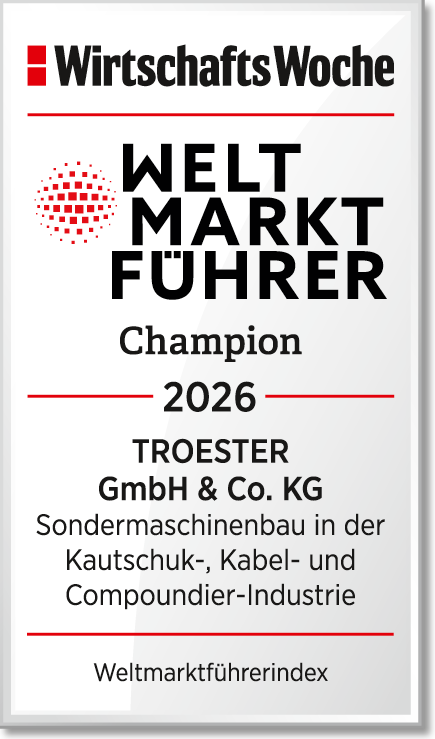125 Years of Excellence in Extrusion
TROESTER has a long history in mechanical engineering. Engineer Paul Troester spontaneously founded his own company on July 4, 1892, after his colleagues of Eisenwerk Wülfel dismissed his ideas.
Toward the end of the 19th century, the region around Hanover had developed into a hub for the rubber-processing industry. The background was the increasing demand for rubber products and rubber tires for the burgeoning automobile industry. Paul Troester wanted to manufacture the required machines on site, instead of importing them from abroad, which was quite cumbersome. The idea to found the TROESTER plant was born.
Clients around the world appreciate solutions from a single source
125 years later, the family-run company has long since developed into one of the market leaders for technical rubber sheets, tire components, profile & hose systems plus cable machines and cable systems. Export plays a major role: TROESTER yields 90 percent of its revenue abroad. Last year, the TROESTER group generated sales of over 120 million Euros and has over 600 employees at its main plant in Germany and the subsidiaries and representative offices in the USA, China, Switzerland, Mexico and India. In 2011, the TROESTER Group was joined by Swiss company
X-Compound, a specialist for plastics-processing and a manufacturer of continual kneaders.
“We now offer our clients a total package of planning and concept, production and installation as well as on-site maintenance”, explains Dr. Peter Schmidt, TROESTER’s Managing Partner. Then as today the big names in the tire and rubber industry as well as major cable manufacturers are amongst the extrusion specialist’s clients.
Successful through difficult times
Before the First World War broke out, TROESTER had established itself as a manufacturer of special machines for the rubber-processing industry. The company was economically well-positioned, however TROESTER was faced with new challenges during the war and post-war turmoil. The good times returned in 1924, with Carl Bredemeyer who took the destiny of the company into his hands. As part of the Buna programme, TROESTER experienced an economic high point in the 1930s. The company profited from the development of synthetic rubber and thermoplastics. The equipment manufacturer conquered new business sectors, for instance with extruders for PVC processing.
Yet the Second World War brought difficult times, even for TROESTER. After 1945, the plant in Wülfel had virtually been completely destroyed by two air strikes. However, currency reform, the lifting of seizure by British military authorities and the Marshall Plan ensured that relations were soon normalised. The reconstruction of the destroyed facilities began, and TROESTER presented itself to the public for the first time in 1947, on order of the British organised “Export Trade Fair Hannover”, the predecessor of what later became the “Hanover Fair”.
Employee know-how is the best capital
Over the years, TROESTER has developed from a classic equipment manufacturer to a system provider, accountable for comprehensive electronics, controlling and automation of state-of-the-art units, in addition to manufacturing. Among other things, the company is based on in-depth research and development work, which has always been a top priority at TROESTER. The company spends about 2 percent of its revenue on these areas. Key competencies and special know-how stay in the company: “Courage and tireless commitment are characteristics that have shaped TROESTER since its founding”, says General Manager Dr. Peter Schmidt, who took over managing the company from his father in 2003. “The workers and staff feel like they are part of a family”, says Schmidt. On average, each employee has been in the company for about 16 years, while many are celebrating their 25th and even 40th anniversaries at TROESTER.
TROESTER is equipped for the future
TROESTER is committed to its location in Germany. As part of restructuring and optimisation of production conditions at the Wülfel plant, a new production hall with a surface area of 3,200 square meters was constructed in 2016. A second construction phase with several buildings follows in 2017, which will expand the factory premises in Hanover to over 25,000 square meters – about 15,300 of which is production space – thereby positioning TROESTER’s capacities and plant logistics for the future. New investments are already in planning to equip the company for the challenges of “Digitisation” and “Industry 4.0”.
-
No older news available
-
HF Group transfers its Extrusion Technology Business to TROESTER
Harburg-Freudenberger Maschinenbau GmbH, Hamburg, and TROESTER GmbH & Co. KG, based in Hanover, announce that the HF Group’s Extrusion Technology Business Unit was transferred to TROESTER on May 1st, 2019.
